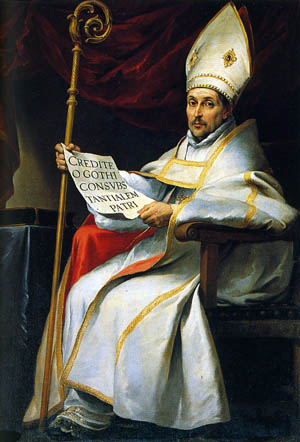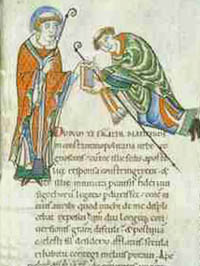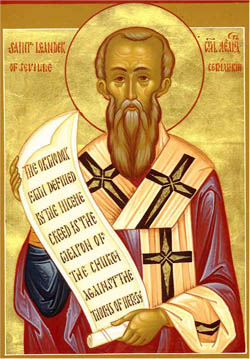 |
The Saint of the Day
St. Leander of Seville, February 27
Prof. Plinio Corrêa de Oliveira
Biographical selection:
St. Leander, a close friend of St. Gregory the Great, was born in Carthagena to a family of high nobility. He was the eldest brother of several saints. His brother, St. Isidore, succeeded him as Bishop of Seville. Another brother, St. Fulgentius, became Bishop of Carthagena, and his sister, St. Florentina, became an Abbess in Carthagena.

St. Leander of Seville
|
When he was still young, Leander retired to a Benedictine monastery where he became a model of learning and piety. In 579 he was raised to the episcopal see of Seville, where he continued to practice his customary austerities and penances.
At that time, a part of the territory of Spain was dominated by the Visigoths. Those barbarians were Arians and had spread their errors in the cities they had conquered. The Iberian Peninsula had been infected by that heresy for 170 years when St. Leander was chosen Bishop of Seville. He began to combat it immediately. With the help of God, to Whom he had recourse, his efforts were successful and the heresy began to lose hold on its followers. He also played an important role in the conversion of Hermenegild, the eldest son of the Visigoth King.
King Leovigild, however, became angry over his son’s conversion and St. Leander’s activity. He exiled the Saint, and condemned his son to death. Later, he repented, recalled the Saint to Spain and asked him to educate and form his other son and successor, Reccared, who became a Catholic and helped the Saint to convert the rest of his subjects.
St. Leander played a central role at two councils, the Council of Seville and the Third Council of Toledo, where Visigothic Spain abjured Arianism in all its forms. He also wrote an influential Rule for his sister with instructions on prayer and renunciation of the world. He reformed the liturgy in Spain, adding the Nicene Creed to the Mass in order to make an express profession of the Faith against Arianism. Later, this practice passed to other Catholic countries. He died in 596.
Comments of Prof. Plinio:
This is a very rich selection that allows many comments.
First, one’s attention is caught by the extraordinary blossoming of saints in that period. In a family of high nobility, there were at the same time St. Isidore of Seville, who was one of the greatest saints of Spanish history, St. Fulgentius, Bishop of Carthagena, St. Florentina, an Abbess, and St. Leander. That is, four saints from the same house, coming from a single noble family of that time. You can see how beautiful it is that all were from the same lineage. It is a way God shows how a family line is useful for His plans.

St. Gregory the Great, left, presents his work Moralia to St. Leander
|
Second, the vitality of sanctity in that epoch is also remarkable. That puissance of sanctity did not come from this or that religious order, but straight from the Holy Ghost. There was no apparent connection between St. Gregory the Great in Italy, these saintly brothers and sister in Spain, and other holy figures in Gaul, Germany, England, etc. These were Saints who often did not even know each other. It does not seem that they were the fruit of a particular movement, but rather, issued from a general and universal action of the Holy Ghost.
This blossoming of saints which inaugurated the Kingdom of Our Lord Jesus Christ in the Middle Ages is one of the most beautiful phenomena in History. That such a marvelous harvest of saints took place in the past leads us to think that there will be another similar blooming of saints that will inaugurate the Reign of Mary.
Third, St. Leander had to face a difficult problem: the heretical barbarians had dominated Spain for 170 years. Those barbarians were not pagans, as many people think. Before the barbarians invaded the Western Roman Empire, a reprobate bishop named Ulfilas had taught among the Germanic tribes in various lands and perverted them to Arianism. So when these tribes invaded Europe, they spread Arianism everywhere. This is what had happened in Spain.
The Catholics in Spain were the descendents of the old citizens of the Roman Empire. They had been defeated and submitted to the Visigoths, who represented the new people full of energy ready to replace the old Romans. The Catholics were oppressed under the yoke of those Arian Visigoths. From a historic perspective, 170 years can appear a short time, but in reality it is not. It represented almost two centuries of consolidated Arian dominion in Spain.

Icon of St. Leander
|
St. Leander was called to overthrow that dominion. How did he carry out his mission? In an admirable way. First of all, by praying to God through the mediation of Our Lady, asking for the necessary supernatural help, aware that without grace, no man relying on only his own means can be successful in his apostolate. Assisted by special graces, he began to preach against Arianism, and the conversions came in colossal numbers. The power of Arianism began to weaken.
The King, furious over such an attack, exiled St. Leander and killed his own son, who became a martyr. Then the King repented, brought back St. Leander and asked him to educate his other son. When Reccared rose to the throne, he helped consolidate the work of St. Leander. It is an admirable example of collaboration between Church and State. The Church, by the voice of a Saint, prepared the situation; the State entered to fully resolve the problem with the cooperation of a faithful King. With this, Arianism disappeared from Spain forever.
These are several aspects of the historic reality that we can discern reading the life of St. Leander of Seville, one of the greatest figures of Spanish history.
Let us ask him to give us his unrelenting spirit to fight against the heresy that resides in Progressivism, a synthesis of all the heresies, which is oppressing Catholics everywhere today.


  | | Prof. Plinio Corrêa de Oliveira | |
The Saint of the Day features highlights from the lives of saints based on comments made by the late Prof. Plinio Corrêa de Oliveira. Following the example of St. John Bosco who used to make similar talks for the boys of his College, each evening it was Prof. Plinio’s custom to make a short commentary on the lives of the next day’s saint in a meeting for youth in order to encourage them in the practice of virtue and love for the Catholic Church. TIA thought that its readers could profit from these valuable commentaries.
The texts of both the biographical data and the comments come from personal notes taken by Atila S. Guimarães from 1964 to 1995. Given the fact that the source is a personal notebook, it is possible that at times the biographic notes transcribed here will not rigorously follow the original text read by Prof. Plinio. The commentaries have also been adapted and translated for TIA’s site.
|
Saint of the Day | Home | Books | CDs | Search | Contact Us | Donate

© 2002- Tradition in Action, Inc. All Rights Reserved
|
 |

|